Crafting a perfect release plan that is aligned to business objectives.
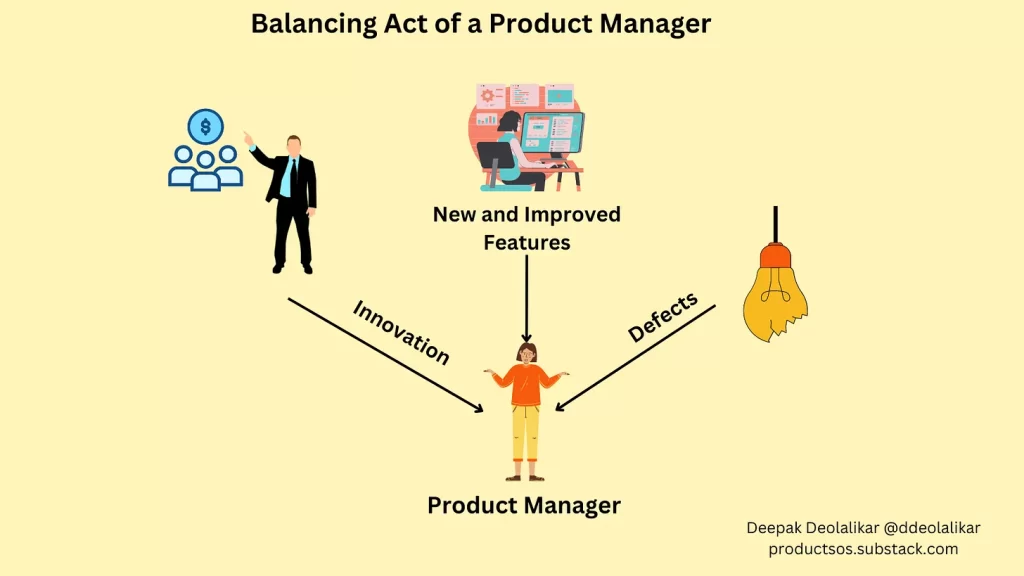
As you plan your work with your engineering for an upcoming release release or upcoming quarter, you will likely be faced with this conundrum of selecting the right set of product priorities.
Without a proper framework for prioritization, there will be endless debates on your choices.
Why are we not innovating?
Why do have so many defects?
When will improve features?
Let’s dive in.
You will have three broad streams of work to select from :
New Innovation
New and Improved features
Defects/ Tech Debt/Infrastructure upgrades
New innovation is something your company has been wanting to get into and the PM team has done discovery and validation. For example, you have a mandate to incorporate AI into your entire product. Or maybe there is a new initiative to create a brand new product or enter a new market. New initiatives are typically geared towards getting new revenue from new customers. It can also be targeted towards existing customers who may be looking for new shiny offerings and keep competition away.
New and Improved features pertain to your usual backlog work in improving the existing product. You want to create more value to your existing customers and ensure they retain in high numbers. It could also be a response to competition which may have released something new capability and your customers also want the same.
Defects are the issues raised by customers or your QA. Tech debt are items that engineering wants to do to continue to improve the performance of the product especially as you scale. Once, my team wanted to upgrade one of the javascript libraries and we kept deferring until we found out that our version is going out of support. We then had to allocate some time to do the upgrade. It was not trivial for a large CRM app with numerous functionality used by 5000 customers.
All of these streams of work are important. New innovation may bring you some press and provide your sales and marketing with ammunition to sell, which is super important, but improvements and making the product ready for scale are equally important, especially for retention.
Here is one reality. You cannot do it all. It’s just physics.
You have limited resources.
This is where the art of prioritization comes into play.
I will not delve into the discovery and validation parts of each initiative. Let’s assume you have done that and you have a good idea on the expected impact. You have your list of initiatives and now you have to prioritize.
Let’s take an example –
Assume there is one PM and 5 engrs on a team. Plus UX and QA. You did discovery, talked to customers, got input from marketing and sales and execs, and support. Here is a short list of prioritized items.
New Initiative 1 – will make us competitive and increase new logos by 10%
New initiative 2 – will help get new customers in a new market for an additional $ 3M revenue
Improvement 1 – Improves overall experience of reporting to 1000 customers
Improvement 2 – Adds new persona to our product which we can charge for add on revenue
Defects – 5 P1 support tickets languishing since 2 quarters (Lets assume P0 are always taken care of)
Tech Debt – Upgrade of library which is going out of support in 2 quarters. Impacts the web app front used by all users. Not doing this will diminish our ability to improve or fix bugs in future.
Defects – Improve query scaling to improve dashboard performance used by 4000 users. 56 customers have reported this issue.
This is what typically happens :
PMs arbitrarily decides the priority based on some criteria such as effort. e.g. they may justify that the new AI thing will take a long time, so let’s just prioritize the few bugs and a couple of improvements. After all the specs and tickets are ready to go. We can keep engineering busy.
The prioritization method used here is basically one of convenience.
That’s lazy prioritization.After some time, there is dissatisfaction amongst stakeholders, executive and product teams about the right balance. Some complain nothing new is coming out of products impacting new sales. Support complains so many defects have not been fixed for months…and so on.
Someone will start a cross functional discussion and will decide on an allocation framework – 40% new work, 40% improvements and 20% defects. Or something like that.
Now, there are few problems with this approachHow do you come up with these percentages? Everyone will have an opinion based on whats important to them. I guarantee there will be multiple meetings just to decide the percent values. Why 30%? Why not 40% for new innovation?
The percent allocation does not take into account the current business context. Whats the business situation of your company in the broader market and economy?
What happens if you have taken up your 40% for new innovation but you cannot fill up defect work? Do you squeeze in more new feature work?
And soon you are back to square one.
I know you have been told on various blogs not to complicate things. Simply focus on the customers core pain points. But you see, all these items above solve important pain points. How do you know that? Because you have done your discovery and validation and came up with a list of many ideas which you then whetted down to a few impactful things. All these items in the list are your priorities.
But you still have to further prioritize. This is the reality of B2B SAAS when you have more than 1000 customers.
Let’s try a different approach. How about we prioritize streams of work based on business impact.
What is business impact?
Whatever you do in product ultimately should result in a positive outcome for your company’s business. Business impact can be any of the following –
Increase Net New Revenue- New or Improved product that allows more customers to buy
Improve NRR – New or Improved capabilities to obtain value from existing customers
Improve GRR – Improve product that prevents customers to churn
Operational continuity – Ensure product continues to work and is scalable
Productivity – Tools to help do more with less e.g. test automation
Lower Costs – Any product related activity that helps lower expenses for the company e.g. moving cloud providers, cheaper vendors or libraries, AI Code builder
As a business, you obviously want all of these. Who does not want new revenue and be productive and lower costs all at the same?
But at any given time, you will likely have 1-2 business impacts that are more important. Which impact is a priority largely depends on the market conditions, competition and the situation with your existing customers.
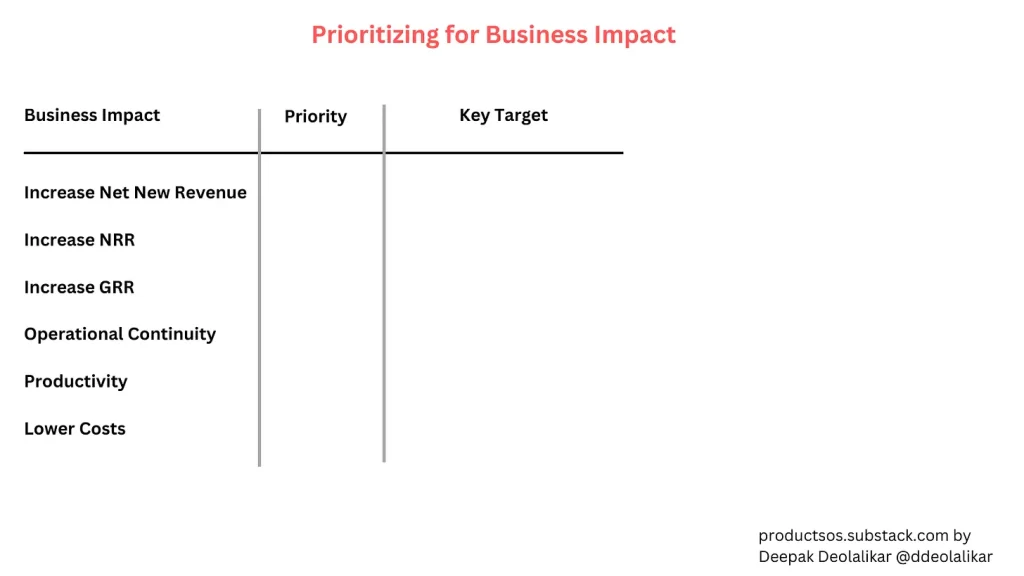
For example –
The economy is in a recession and customers are clamping down on spend. Your sales and marketing may likely change tactics to get new customers. From a product perspective, you can focus your efforts on say increase NRR, GRR from existing customers. Building new innovation for the purposes of going into a new market may not yield the results you are hoping for in such an economy.
What is your competitive position in the market?
If your position is weak, then you will need to make sure your product works flawlessly without significant defects to avoid customer churn and stay ahead of the competition. But if you are a leader, then perhaps you can experiment and work on new innovation and not have to worry so much about losing customers.How is customer satisfaction and sentiment overall with existing customers? Check the customer success metrics for customers who are at risk. Look at the CSAT NPS scores. If your customer satisfaction is low, then you may want to focus on product improvements and fixing defects. If customer satisfaction is very good then you can possibly move on to new innovation.
How is the investment appetite? Say you have convincing proof that Initiative X will move revenue +30% but requires additional resources. Your company many not have the cash or investment appetite yet. This happens a lot in PE backed companies.
Of course, this is not a product management decision alone to decide what the current business imperatives are. Management may decide the priority, and your job as a PM is to translate that into what you can do from a product perspective to achieve these objectives.
Once you have alignment, you can get to the next level of creating a product action plan, that aligns to the business objectives.
This step is often overlooked at many companies. Most PMs team resort to some sort of feature work, and simply hope this will help the customer and further hope it will reduce churn or increase revenue. Most of these plans are not connected and thought through. Connecting your initiatives to business objectives is good use of your teams precious time and resources.
Planning your release
Now dig into each of your identified initiatives. You should have a running list of items in your backlog and these will include items from all three streams. The assumption here is you have already prioritized items that are going to create some kind of impact. For each effort, you quantify the impact. You should already know this when you were planning that work and doing your discovery and validation earlier. Do the same for feature improvements, defects, tech debt etc.
Make sure you articulate the impact of each item in terms of the business impacts listed above i.e. increase net new revenue, increase NRR, GRR etc.
New innovation – How much new revenue or add on revenue is expected?
New and Improved – What is the expected increase in NRR or GRR? Does it help with new sales?
Defects/ tech debt – How many customers/ ARR impacted? What if this impacts one big customer we cannot lose – Note it down.
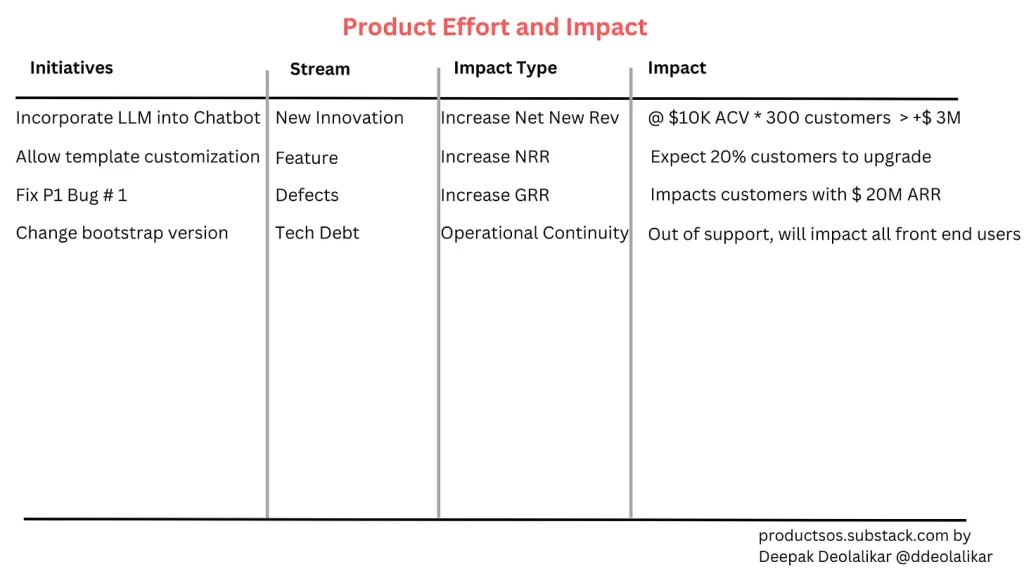
Now comes the crux. You have to create a plan for your release.
Based on the business and product goals, start with the most pressing priority. Let’s say the business priority is to Increase GRR and NRR. Sort list your candidate list to those those items that are marked for Impact type increase NRR, GRR.
Which item do you select first? Ideally you want to select the most impactful one. But there is always some amount of judgement call. e.g. there are two feature improvements and both have similar impact but only one can be done in the upcoming release. Which one do you select?
For instance, you can work with your stakeholders and find out which one is more likely to satisfy customers. Or you can conclude that one prepares the platform to further add new features in future so you prioritize that. Many different ways to select. This is the judgement part.
Now pick the next item. Repeat until you reach your engineering capacity.
Now you have a first cut of prioritized list of items that will also meet your business objectives. It’s a good idea to go back to your original list and confirm you did not miss anything important. Let’s say Item 3 did not make the cut, ask if it can wait another release cycle. If not, can you swap it from something you shortlisted.
Keep in mind, something important will always not be able to make the cut. And you have to be able to cope with that. Some perfectionist product managers might feel bad. But that is the reality of doing business in a resources constrained environment.
What if you absolutely cannot wait a release and you have to get something in. That’s your ask to management for more resources. Be prepared to come up with your business case. Chances are they will ask you to either find a leaner way to do both or just pick one. That’s another judgment call you will have to make.
Some things are no brainers. e.g. that library update might have lesser impact than your AI innovation but it is essential for your business continuity. So it needs to be on table now.
You will of course need buy in from your management and stakeholders. When you present your plan, make sure to include :
Customer outcomes
What are the outcomes that the customer are going to expect?
Expected business impact
What are the expected revenue add to the business?
Tradeoffs
What are we not doing what is the impact ? This is very important.
By focusing the core business objectives you are going to trade off some other objective, which will be reflected in your plan.
What kind of tradeoffs should be expected?
If you put lower emphasis on :
New Innovation, then
No new products to show to customers
Sales and marketing have to consistently work on messaging for the existing product
New and Improved Features, then
Existing customers may complain and may result in churn
No new features may lead to product stagnation
Defects/tech debt, then
Quality might suffer
Support may have to field more than usual number of tickets
Once you have crafted your product plan, use the template below to document your plan.
Use this to get stakeholder as well as management buy in. That way you can be sure that you are not missing any major activities that you should be working on. It is also useful to ensure that all stakeholders are aligned and they adjust their own priorities.
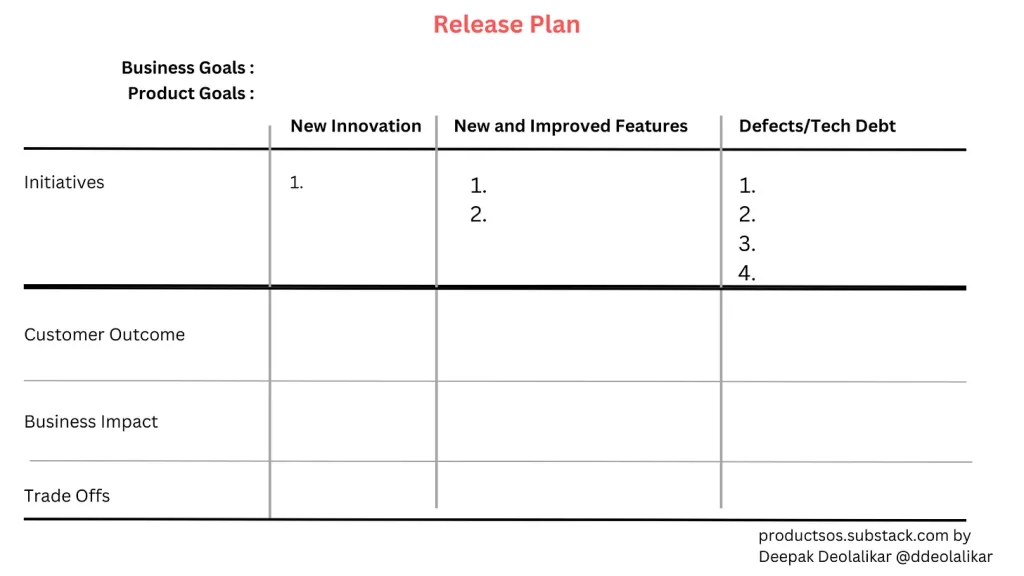
Be careful, your product culture will bias you.
say you came out of hyper growth ….you will be biased to new innovation because you have seen the success
If you have happy customers, you want to keep them satisfied at all costs. So fix more bugs, and give more improvement – even if it does not create a significant impact compared to other things.
Conclusion
To summarize, these are the steps towards creating your near perfect release plan that is aligned to core business objectives.
Determine the core business priorities of the company
Make your candidate list across the three streams along with the impact of each
Select from the list that meet the business objectives
Assess the tradeoffs
Obtain buy in from management
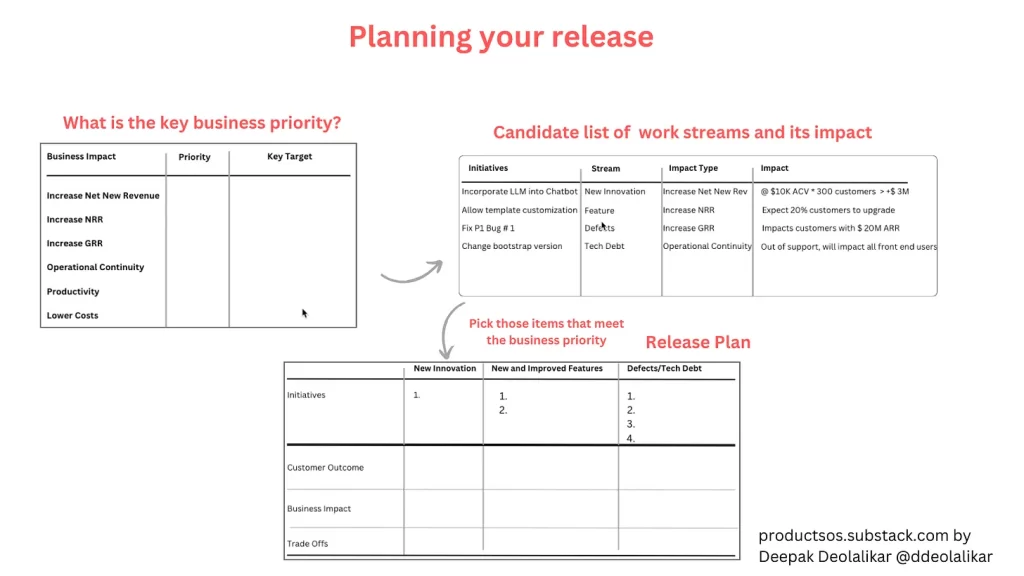
This is not a perfect process but gets you started. At the very least it forces you to seriously consider the business impact as a criteria.
The big debates are not about how much to focus on new innovation vs improvements or fixes. Rather, the discussion is now focussed on which initiatives to select that has a better chance of meeting your key business objectives.
With this approach, you have aligned your objectives, you selected initiatives that are impactful, and everyone understands the trade offs.
Remember, this is not meant to be a mathematical or spreadsheet exercise. As you can see, you have to sometimes make a judgement call.
Do you want to try this for your product planning?

